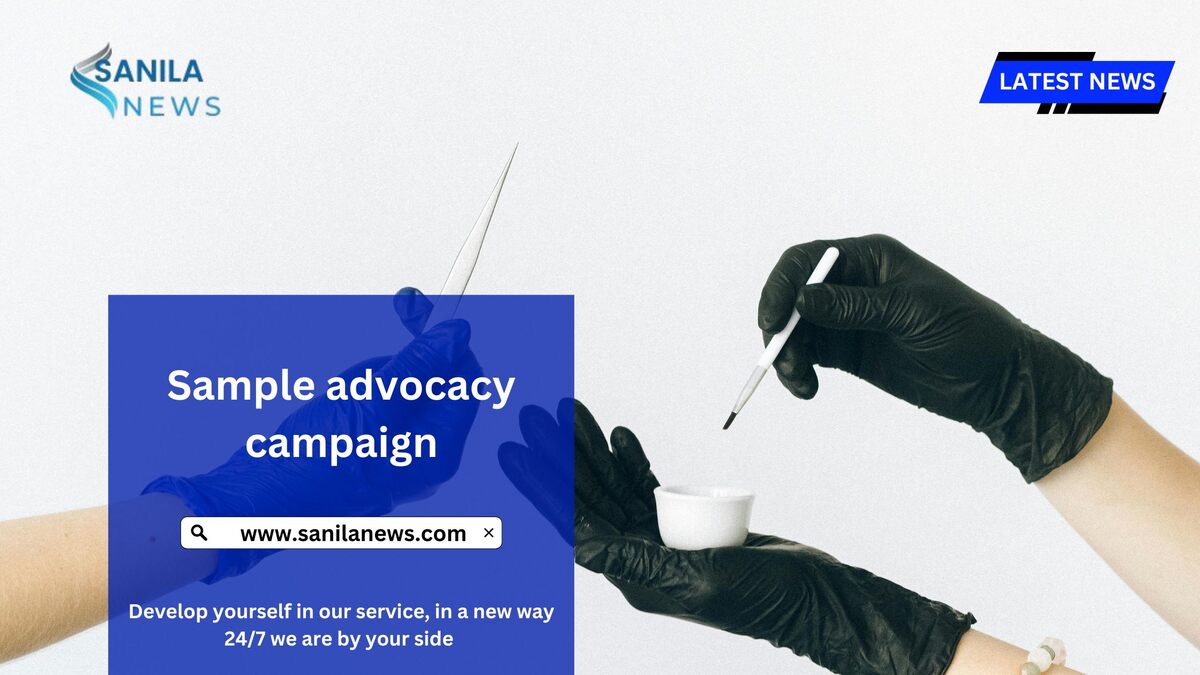Sample advocacy campaign: Creating a compelling advocacy campaign involves articulating a clear mission, identifying key stakeholders, and crafting a persuasive narrative to inspire action. Below is a sample advocacy campaign, with a focus on environmental sustainability, aiming to address the issue of plastic pollution. This campaign is hypothetical and titled “Break Free From Plastic.”
Sample Advocacy Campaign: Break Free From Plastic
Campaign Mission:
To reduce plastic pollution by advocating for policies, promoting sustainable alternatives, and inspiring individuals and businesses to take meaningful steps toward reducing plastic waste.
Introduction:
Plastic pollution is one of the most pervasive environmental challenges today. Each year, more than 8 million tons of plastic end up in our oceans, threatening marine life, ecosystems, and even human health. Despite growing awareness, the global reliance on plastic—particularly single-use plastics—continues to rise. Our mission is to inspire systemic change by encouraging governments, businesses, and individuals to “Break Free from Plastic.”
This campaign seeks to raise awareness, advocate for sustainable alternatives, and push for policies that will reduce plastic production and waste. Through a combination of public education, community organizing, policy advocacy, and partnerships, we aim to create lasting change at local, national, and international levels.
The Problem:
Plastic is everywhere. From the packaging of our food and products to the fibers in our clothes, plastic has become an integral part of modern life. Unfortunately, its widespread use has led to catastrophic environmental consequences.
- Plastic in the Oceans: Approximately 8 million tons of plastic enter the oceans each year. This waste creates massive “plastic islands” and harms marine animals who mistake it for food. By 2050, there could be more plastic than fish in the ocean if current trends continue.
- Microplastics: Plastic waste doesn’t just stay large—it breaks down into smaller pieces called microplastics, which are now found in our water, soil, and even in the food we eat. The long-term health effects of microplastics on humans are still unknown, but early studies suggest potential harm.
- Carbon Footprint: The production and incineration of plastic contribute significantly to greenhouse gas emissions. Every step of plastic’s lifecycle—from extraction to disposal—creates a carbon footprint, exacerbating climate change.
- Inefficient Recycling: While recycling is often touted as a solution, only 9% of the world’s plastic has been recycled. Most of it ends up in landfills or incinerators, or as litter in our environment.
Sample Advocacy Campaign Goals:
- Raise Awareness: Educate the public about the harmful effects of plastic pollution on the environment, wildlife, and human health.
- Policy Advocacy: Push for stronger legislation to reduce plastic production, ban single-use plastics, and hold corporations accountable for plastic waste.
- Promote Alternatives: Encourage businesses to adopt sustainable alternatives to plastic and promote a circular economy.
- Empower Communities: Mobilize communities to take local action through beach clean-ups, plastic bans, and education initiatives.
- Corporate Accountability: Advocate for Extended Producer Responsibility (EPR) policies, which place the responsibility for managing the end-life of plastic products on the companies that produce them.
Target Audience:
To create widespread change, this campaign must reach multiple audiences, each with a tailored approach.
- General Public: Individuals are key to reducing plastic waste in their daily lives. Through public education, we aim to shift consumer behavior and encourage sustainable choices.
- Policymakers: Legislators at local, national, and international levels have the power to create systemic change. We will advocate for comprehensive plastic regulation, including bans on certain single-use plastics, incentives for using sustainable materials, and funding for waste management infrastructure.
- Corporations: Businesses must be held accountable for the plastic they produce. Through direct engagement and public pressure, we will encourage corporations to phase out plastic packaging, adopt eco-friendly materials, and support a circular economy.
- Environmental NGOS: Collaboration with other environmental organizations will strengthen the campaign’s reach and impact. We will work together to amplify our message, share resources, and organize joint actions.
- Schools and Educational Institutions: Engaging young people is crucial for building long-term sustainable habits. We will develop educational programs and campaigns to teach students about plastic pollution and its impact.
Key Messages:
- Plastic Pollution is Preventable: We have the tools, technologies, and alternatives to reduce plastic waste. What we need is the collective will to act.
- Everyone Has a Role to Play: Whether you’re an individual, a business owner, or a policymaker, there are actions you can take to reduce plastic waste. From refusing single-use plastics to advocating for policy changes, every step matters.
- Plastic Harms Our Health and Environment: It’s not just about marine life. Microplastics are in our food and water, and the chemicals used in plastic production are harmful to our health and the planet.
- Sustainable Alternatives Are Possible: Many companies are already adopting innovative solutions to reduce plastic use. We must push for widespread adoption of these practices and support businesses that prioritize sustainability.
- Systemic Change is Necessary: While individual actions are important, we cannot solve the plastic crisis without addressing the root causes—overproduction of plastic, lack of corporate responsibility, and insufficient regulation.
Sample Advocacy Campaign Tactics:
- Public Education and Outreach:
Education is at the heart of our campaign. We will launch a comprehensive public education program using various media to raise awareness about the impact of plastic pollution and the steps individuals can take to reduce their plastic footprint.
- Social Media Campaign: We will create shareable content—videos, infographics, and stories—highlighting the dangers of plastic pollution and offering actionable solutions.
- Public Service Announcements: Collaborate with local TV and radio stations to broadcast PSAs that inform the public about plastic pollution and encourage behavior changes like using reusable bags and bottles.
- Workshops and Webinars: Host workshops and webinars for communities, schools, and businesses on how to reduce plastic waste, implement recycling programs, and switch to sustainable alternatives.
- Influencer Partnerships: Engage with influencers and public figures who are passionate about environmental issues to help spread our message to a wider audience.
2. Policy Advocacy:
Effective legislation is crucial for reducing plastic pollution. We will advocate for the following policy changes:
- Ban on Single-Use Plastics: Advocate for the phased ban of items like plastic straws, bags, cutlery, and packaging. Support local governments that introduce plastic bans and help them enforce these policies.
- Tax on Plastic Products: Push for a plastic tax on items that are difficult to recycle, encouraging manufacturers to switch to biodegradable alternatives.
- Extended Producer Responsibility (EPR): Campaign for policies that require companies to take responsibility for the entire lifecycle of their plastic products, from production to disposal.
- Plastic Waste Management: Lobby for increased funding for waste management infrastructure, particularly in developing countries where plastic waste is often dumped into oceans.
- International Cooperation: Support global efforts like the United Nations Environment Assembly (UNEA) to create binding international agreements on plastic pollution.
- Community Engagement:
Communities can drive change from the ground up. We will work with local groups, schools, and activists to create community-based initiatives.
- Beach and River Clean-Ups: Organize regular clean-up events to remove plastic waste from beaches, rivers, and natural spaces. Partner with local environmental groups and volunteers to ensure consistent efforts.
- Plastic-Free Schools Program: Develop a toolkit for schools to go plastic-free, including educational materials, reusable alternatives, and waste management strategies.
- Plastic-Free Pledge: Encourage individuals, businesses, and local governments to take the Plastic-Free Pledge—a commitment to reducing or eliminating plastic use in daily operations.
4. Corporate Engagement and Accountability:
To achieve systemic change, corporations must be held accountable for their role in plastic pollution. We will engage businesses through:
- Sustainable Business Certification: Develop a certification program for businesses that meet strict sustainability criteria, including reducing plastic packaging and using eco-friendly materials.
- Public Pressure Campaigns: Identify major corporations contributing to plastic waste and launch targeted campaigns to pressure them to change their practices. This could include petitions, social media actions, and shareholder activism.
- Partnerships with Eco-Friendly Brands: Highlight companies that are leading the way in plastic reduction, and work with them to promote their sustainable practices.
- Monitoring and Reporting:
Tracking progress is critical to ensuring accountability and transparency. We will:
- Release Annual Reports: Publish an annual “State of Plastic Pollution” report that highlights key achievements, challenges, and progress toward our goals.
- Monitor Corporate Commitments: Track and report on the commitments made by companies to reduce plastic waste and hold them accountable for their promises.
Timeline:
The campaign will run over three years, with each year focused on specific goals:
- Year 1: Awareness and Community Engagement—Focus on educating the public, building partnerships, and mobilizing communities to take action.
- Year 2: Policy and Corporate Accountability—Intensify advocacy efforts aimed at policymakers and corporations, pushing for concrete legislative changes and business commitments.
- Year 3: Scaling Impact—Expand the campaign’s reach through international collaboration and ensure long-term sustainability by securing commitments from key stakeholders.
Conclusion:
The Break Free From Plastic sample advocacy campaign is more than just an environmental movement—it’s a call to action for everyone. The plastic crisis is solvable, but it requires collective effort from individuals, communities, businesses, and governments. By raising awareness, advocating for stronger policies, promoting sustainable alternatives, and holding corporations accountable, we can create
Last word
Keep an eye on our news channel Sanila News to get updated news regularly.

